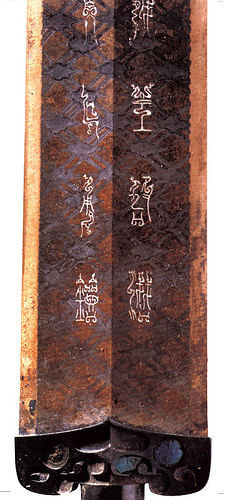The Sword of King Câu Tiễn
 King Câu Tiễn (or Kou Chien/Goujian in Chinese) was a ruler during ancient times. Câu Tiễn was the leader of the Kingdom of Yueh, over 2500 years ago, at the dawn of the Warring States. Yueh was one of the contending states during the Spring and Autumn period, after the fall of the Eastern Zhou. Under the leadership of King Câu Tiễn, the Yueh Kingdom broke free from the grasp of the ancient Wu, re-emerged to conquer that Wu kingdom, and became one of the more powerful states of this era. The Yueh Kingdom would reign for several centuries, before being swallowed up by the State of Chu.
King Câu Tiễn (or Kou Chien/Goujian in Chinese) was a ruler during ancient times. Câu Tiễn was the leader of the Kingdom of Yueh, over 2500 years ago, at the dawn of the Warring States. Yueh was one of the contending states during the Spring and Autumn period, after the fall of the Eastern Zhou. Under the leadership of King Câu Tiễn, the Yueh Kingdom broke free from the grasp of the ancient Wu, re-emerged to conquer that Wu kingdom, and became one of the more powerful states of this era. The Yueh Kingdom would reign for several centuries, before being swallowed up by the State of Chu.
Today, in a museum exhibit somewhere in China, lays the sword of King Câu Tiễn. Shown here are photos of the exact same blade wielded by the King of Việt over 2500 years ago. If you look closely, you will notice the very interesting writing located on the face of the sword. I’m no expert in Chinese literature, nor am I an expert in ancient Việt texts. It doesn’t take an expert however, to notice the damning resemblance with the writing on this sword and the Nôm characters of ancient Việt.
It is very interesting that in Chinese history, Việt Vương Câu Tiễn (Kou Chien, King of Yueh) was said to be a Chinese man. Obviously, with the fact that the Yueh Kingdom was located where the Bách Việt used to be, and that the name Yueh directly translates to mean Việt, it is clear that Kou Chien is Vietnamese. Even more interesting are the writing found on his blade, which shares a shocking resemblance to the ancient scriptures of the Bách Việt civilization.
During the period of the Spring and Autumn, and the era of the Warring States, the country known as China had not yet been formed. Instead, many independent states emerged, each with their own ways of communicating. It just so happens that the Kingdom of Việt’s system of writing were the Nôm from Bách Việt. The writing on King Câu Tiễn’s sword is different from the writing of the later imperial Chinese, and strongly suggests that the Kingdom of Việt communicated using the ancient Nôm of Bách Việt. Furthermore, the grammar on the sword is distinct from the Chinese, meaning that Câu Tiễn not only wrote in Vietnamese, but spoke Vietnamese as well.
http://freedomforvietnam.wordpress.com/2011/04/25/the-sword-of-king-cau-thien/


 Ngày khởi sự
Ngày khởi sự


No Comment.